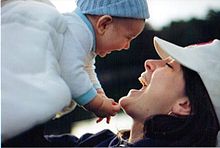A maternal bond is the relationship between a biological mother/caregiver and her child or baby. While typically associated with pregnancy and childbirth, a maternal bond may also develop in cases later on in life where the child is unrelated, such as in the case of an adoptee or a case of blended family.



Both physical and emotional factors influence the mother-child bonding process. In separation anxiety disorder a child becomes fearful and nervous when away from a loved one, usually a parent or other caregiver. New mothers do not always experience instant love toward their child. Instead, the bond can strengthen over time, or fail to develop. Bonds can take hours, days, weeks, or months to develop.[1]
Pregnancy
editThe maternal bond between a woman and her biological child usually begins to develop during pregnancy. The pregnant female often adapts her lifestyle to suit the needs of the developing infant, for example by eating or retaining from eating certain foods or undertaking or avoiding certain activities. At around 18 to 25 weeks, the mother begins to feel the fetus moving. Similar to seeing her child for the first time in an ultrasound scan, this experience often leads the mother to feel more attached to her child [citation needed].
Once sufficiently developed, the developing fetus has some awareness of the mother's heartbeat and voice and can respond to touch or movement and hear sounds from the surrounding environment. By the seventh month of pregnancy, two-thirds of women report a strong maternal bond with their unborn child.[1]
Some mothers who did not want the pregnancy may not have a close relationship with their child due to a sense of foreigness/unfamiliarity.[2] They are more likely to suffer from post-partum depression or other mental health problems and less likely to breastfeed.[2]
Childbirth and post pregnancy
editChildbirth is an experience that can strengthen the mother and child bond. Factors such as a traumatic birth, the mother's childhood, medical stress, lack of support and the influence of a spouse or partner/family or socioeconomic factors like poverty can weaken the bond.
Physical contact between infants and caregivers is very important to building, and bonding is still possible for infants which require hospital care which reduces the opportunities for physical contact, for example those infants who are born prematurely. Parents and premature infants can still bond by cuddling and hugging, by touching in and around incubators, and by playing, with skin to skin like firms of contact particularly effective.[3]
Emotional bonding theory first appeared in the mid-1970s [4] and bonding theories outlining descriptions and causes of good bonding and poor bonding were established understandings by the mid 1980s.
Oxytocin
editProduction of oxytocin during childbirth and lactation increases parasympathetic activity. Thus, anxiety is theoretically reduced. Maternal oxytocin circulation is said to predispose women to bond and show bonding behavior,[5][6] although this has been disputed.[7]
Breastfeeding is also strongly believed to foster the bond, via touch, response and mutual gazing as it stimulates the experience with the baby gazing up and down the mother and drinking from the mother's nipples.[8]
Maternal separation anxiety
editBeginning at 9–10 months of age when infants begin to crawl and then when they begin to walk around 12 months of age, they begin to develop capacities to physically explore the world away from their mother.[9] These capacities bring with them separation anxiety as the infant becomes more vulnerable away from mother. This newly acquired motor development parallels infants' intellectual curiosity, and cognitive and language development as they begin to point and name, and jointly attend with mothers to their environment beginning by 9–10 months. Most parents welcome these explorations and this increased independence. However, in the context of maternal depression, trauma or disturbed bonding in her own early life, some mothers have significant difficulty in tolerating the exploration and-or the infant's anxiety.[10]
This separation anxiety increases when infants and toddlers feel threatened or socially reference their mothers for reassurance. The research claimed out that mothers, for example, with histories of violence exposure and post-traumatic stress show less activity in the medial prefrontal cortex, a brain area that helps to temper and contextualize fear responses, and thus are likely unable to extinguish their fear response upon watching a videotaped mother-toddler separation scene in a magnetic resonance imaging scanner.[11]
Child separation anxiety
editInevitably, children who have rarely been separated from their mother become anxious when separated for extended periods. This is most commonly experienced when starting to attend school. Separation anxiety can cause children to be unable to be open to new experiences such as attending school regularly. There is a relationship between child separation anxiety and school refusal.[12]
Attachment happens after childbirth and does not form and is likely more fluid as you go further in later in life, this anxiety can reoccur if mothers have to leave their family unit to work. In both cases, the child's anxiety (and that of the parents) can be reduced by priming, i.e. preparing the child for the experience before its occurrence and by creating and maintaining dialogue and connection between the absent parent and child during the separation. Many children may experience such anxiety in various forms.[13] Child separation anxiety may be a learned behaviour which can occur over time initiating from innate fears of separation or trauma.[14]
See also
editFootnotes
edit- ^ a b Winkler J (January 2000). "[Development of the maternal bond during pregnancy]" [Development of the maternal bond during pregnancy]. Casopis Lekaru Ceskych (in Czech). 139 (1): 5–8. PMID 10750284.
- ^ a b [Only 20% of mothers felt that they have an actual connection with a child, within hours of delivery. (steinfield) https://www.webmd.com/parenting/baby/forming-a-bond-with-your-baby-why-it-isnt-always-immediate http://healthypeople.gov/2020/topicsobjectives2020/overview.aspx?topicid=13 "Family Planning – Healthy People 2020"]. HealthyPeople.gov. Retrieved 2011-08-18.
{{cite web}}: Check|url=value (help) This reference cites:- Logan C, Holcombe E, Manlove J, et al. (May 2007). The consequences of unintended childbearing: A white paper (PDF) (Report). Washington: Child Trends. Archived from the original (PDF) on July 2, 2010. Retrieved March 3, 2009.
- Cheng D, Schwarz EB, Douglas E, Horon I (March 2009). "Unintended pregnancy and associated maternal preconception, prenatal and postpartum behaviors". Contraception. 79 (3): 194–198. doi:10.1016/j.contraception.2008.09.009. PMID 19185672.
- Kost K, Landry DJ, Darroch JE (Mar–Apr 1998). "Predicting maternal behaviors during pregnancy: does intention status matter?". Family Planning Perspectives. 30 (2): 79–88. doi:10.2307/2991664. JSTOR 2991664. PMID 9561873.
- D'Angelo DV, Gilbert BC, Rochat RW, Santelli JS, Herold JM (Sep–Oct 2004). "Differences between mistimed and unwanted pregnancies among women who have live births". Perspectives on Sexual and Reproductive Health. 36 (5): 192–197. doi:10.1111/j.1931-2393.2004.tb00022.x. PMID 15519961.
- ^ "Bonding with sick or premature babies in the NICU".
- ^ Spinner MR (November 1978). "Maternal-infant bonding". Canadian Family Physician. 24: 1151–1153. PMC 2379718. PMID 21301556.
- ^ Chiras DD (2012). Human Biology (7th ed.). Sudbury, MA: Jones & Bartlett Learning. p. 262. ISBN 978-0-7637-8345-7.
- ^ Gray PB (2010). "The Evolution and Endocrinology of Human Behavior: Differences and Reproduction.". In Muehlenbein MP (ed.). Human Evolutionary Biology. Cambridge University Press. pp. 277–292 (282). doi:10.1017/CBO9780511781193.020. ISBN 978-1-139-78900-4.
- ^ Fillod O (2014). "Oxytocin as proximal cause of 'maternal instinct': weak science, post-feminism, and the hormones of mystique". In Schmitz S, Höppner G (eds.). Gendered neurocultures: feminist and queer perspectives on current brain discourses. challenge GENDER, 2. Wien: Zaglossus. ISBN 9783902902122.
- ^ Else-Quest NM, Hyde JS, Clark R (2003-10-01). "Breastfeeding, bonding, and the mother-infant relationship". Merrill-Palmer Quarterly. Retrieved 2008-03-13.
- ^ Schaffer HR (2004). Introducing Child Psychology. Oxford: Blackwell. ISBN 978-0-631-21627-8.
- ^ Pelaez M, Virues-Ortega J, Field TM, Amir-Kiaei Y, Schnerch G (December 2013). "Social referencing in infants of mothers with symptoms of depression". Infant Behavior & Development. 36 (4): 548–56. doi:10.1016/j.infbeh.2013.05.003. PMID 23756225.
- ^ Schechter DS, Moser DA, Paoloni-Giacobino A, Stenz L, Gex-Fabry M, Aue T, et al. (2015). "Methylation of NR3C1 is related to maternal PTSD, parenting stress and maternal medial prefrontal cortical activity in response to child separation among mothers with histories of violence exposure". Frontiers in Psychology. 6: 690. doi:10.3389/fpsyg.2015.00690. PMC 4447998. PMID 26074844.
- ^ Tekin, Işıl; Aydın, Selami (November 2022). "School refusal and anxiety among children and adolescents: A systematic scoping review". New Directions for Child and Adolescent Development. 2022 (185–186): 43–65. doi:10.1002/cad.20484. ISSN 1520-3247. PMID 36161758. S2CID 252536285.
- ^ Wehry, Anna M.; Beesdo-Baum, Katja; Hennelly, Meghann M.; Connolly, Sucheta D.; Strawn, Jeffrey R. (July 2015). "Assessment and Treatment of Anxiety Disorders in Children and Adolescents". Current Psychiatry Reports. 17 (7): 52. doi:10.1007/s11920-015-0591-z. ISSN 1523-3812. PMC 4480225. PMID 25980507.
- ^ Masson, Céline (2001). "Le supplice des mères : le fil de l'angoisse transgénérationnelle". Cliniques méditerranéennes. 64 (2): 135–156. doi:10.3917/cm.064.0135. ISSN 0762-7491.